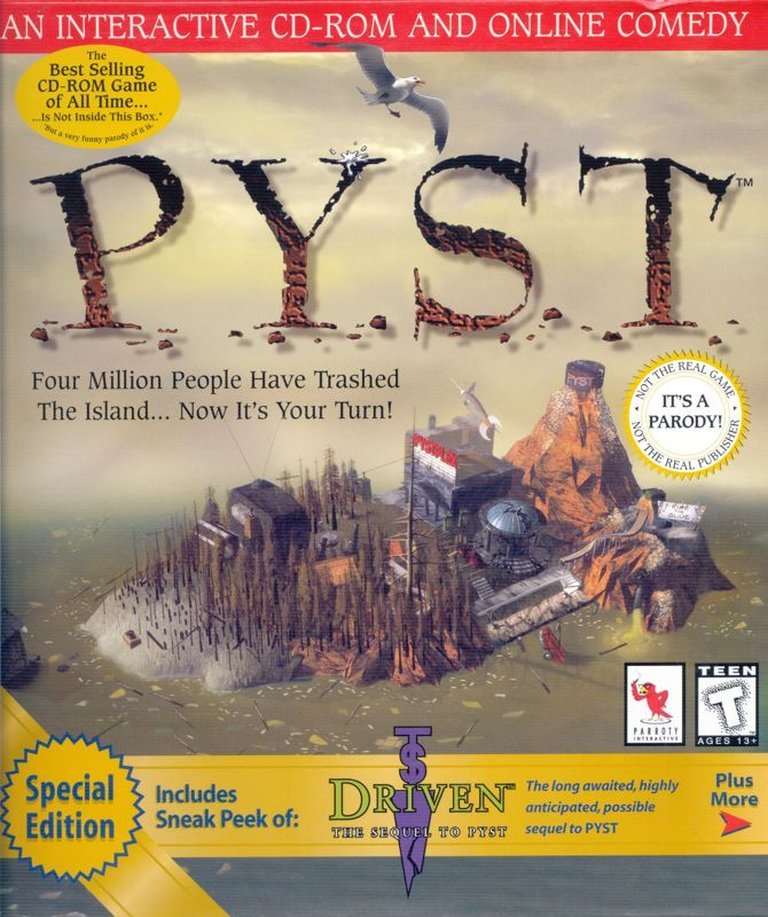- Release Year: 1997
- Platforms: Macintosh, Windows 16-bit, Windows
- Publisher: Palladium Interactive, Inc.
- Genre: Special edition
- Game Mode: Single-player
- Average Score: 40/100

Description
Pyst (Special Edition) is an enhanced version of the 1996 parody adventure game that humorously spoofs the popular Myst series. Released in 1997, it includes the original game along with sneak peeks of upcoming Parroty Interactive titles like Driven, Star Warped, and The X-Fools. Featuring live-action cut-scenes and multi-platform support for Windows 3.x, Windows 95, and Macintosh, this special edition offers a comedic take on the adventure genre with a focus on irreverent humor and cultural satire.
Pyst (Special Edition) Reviews & Reception
mobygames.com (40/100): Four million people have explored the world of Myst—and they’ve turned it into a dump.
Pyst (Special Edition): Review
Introduction
In the mid-1990s, Cyan’s Myst captivated millions with its enigmatic islands and atmospheric puzzling. Enter Pyst, a bold parody from Parroty Interactive that promised to turn the Myst experience on its head by showing the island after being ravaged by millions of virtual tourists. The Special Edition adds samplers for never-released sequels, making it a must-examine piece of gaming history.
Development History & Context
Parroty Interactive, a division of Palladium Interactive, was founded to create National Lampoon-esque humor for the burgeoning CD-ROM market. Pyst’s development aimed to create a transformative work that moved beyond Myst’s gameplay while parodying its themes. With a team that included Firesign Theatre’s Peter Bergman and actor John Goodman, the project blended comedy theater with video game design. Technological constraints of the era meant relying on pre-rendered images and full-motion video, which limited interactive depth but allowed for rich visual humor.
Narrative & Thematic Deep Dive
Pyst Island is Myst Island defiled: litter strewn everywhere, buildings in ruins, and graffiti revealing puzzle solutions. King Mattruss, played by Goodman, serves as a sarcastic guide. The narrative deconstructs Myst’s solitude and mystery by presenting an over-touristed, commercialized nightmare. Themes of environmental degradation and the commodification of experiences are laced with absurdist humor. However, the story lacks Myst’s narrative depth, relying more on visual gags and one-liners.
Gameplay Mechanics & Systems
Pyst abandons Myst’s puzzle-solving for a simplified exploration model. Players navigate through pre-rendered scenes using a postcard-like interface with arrow buttons. There’s no inventory or complex interaction—just clicking to move between scenes. This lack of gameplay mechanics was a common criticism; while novel, it fails to engage players beyond a surface-level chuckle.
World-Building, Art & Sound
The art direction masterfully inverts Myst’s tranquility with chaos and decay. Ruined structures, broken objects, and humorous graffiti create a vivid, if bleak, atmosphere. John Goodman’s live-action performances add a layer of comic relief, though the dated production values are noticeable. The sound design blends comedic voiceovers with whimsical music, creating an auditory landscape that reinforces the parody.
Reception & Legacy
Initial reviews were mixed. Critics praised the humor and novelty but condemned the lack of substantive gameplay. Despite selling over 200,000 copies, it didn’t achieve Myst’s commercial success. However, Pyst is remembered as the first significant video game parody, influencing subsequent parodies like Star Warped and inspiring exploration-focused games like Gone Home. Its inclusion of samplers for unreleased sequels makes the Special Edition a unique artifact for gaming historians.
Conclusion
Pyst (Special Edition) holds a pivotal place in video game history as a pioneering parody. While it falls short in gameplay depth, its innovative approach to comedy and world-building deserves recognition. As a product of its time, it serves as a fascinating snapshot of 1990s CD-ROM culture and the intersection of technology with absurdist humor.